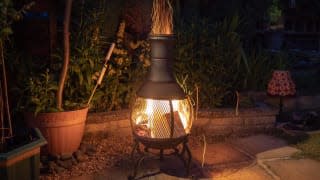Chimineas Add Outdoor Heat That's Easy to Manage

Consumer Reports has no financial relationship with advertisers on this site.
Like a fire pit, a chiminea burns wood to provide warmth outdoors. But it can be easier to enjoy than a pit because smoke flows up the chimney and not into anyone’s face.
While they vary in shape, size, and material, they all work the same way. A small firebox, often elevated off the ground with a base or legs, keeps the fire closer to eye level. Chimineas are usually smaller than fire pits, which means they can be good options for smaller gatherings.
Newer designs made of sheet metal can offer a 360-degree view of the fire. Older clay and iron versions have a smaller opening that decreases the viewing angle and seating options if everyone wants a good view of the fire.
Clay is the most traditional chiminea material, and while those versions might have old-world charm, they're heavy. A modest 37-inch-tall model can weigh about 75 pounds. Plus, clay is susceptible to freezing and cracking if left out in colder climates. Home centers and hardware stores tend to have a smaller clay chiminea selection vs. fire pits or patio heaters, so you might have to head online to find a larger selection. Expect to pay about $250 to about $500 for a 49-inch-tall model from brands such as Harward.
Cast-iron chimineas are more durable than clay if you keep rust at bay, but their weight makes them an almost permanent fixture in the yard. These models, from brands such as Wendling Cast and Hundley, can be even harder to find in stores, and if you’re buying online, shipping can be pricey. A 55-inch-tall cast iron chimenea can weigh about 170 pounds and cost around $400. A cast-iron chiminea with a more ornate design can run about $700 for a similar size.
The lightest-weight chimineas are made of sheet metal, coming in a range of materials such as stainless steel or copper. This style often has an open firebox, so you can use them much like a fire pit. Brands such as Shook Steel and Sunnydaze Décor, among others, have a range of styles including traditional, contemporary, and modern. They can be far lighter than chimineas made of other materials—a 70-inch-tall sheet-metal chiminea can weigh a manageable 40 pounds—so these are the easiest move around, though rusting can be an issue.
The Setup
While they can be heavy, a chiminea is pretty easy to manage once you get past the initial setup. Some styles, like clay models, might come in two pieces, requiring assembly. Once you build a fire, there isn’t much you have to do to keep the flames going besides adding fuel.
Depending on your chiminea’s material, you may want to build your fire on a metal grate or a bed of sand. The base on most models means they can be easier to use on patios without fear of damaging the stone below, though you should always check the manufacturer's recommendation for placement before buying.
A chiminea requires stable footing because it radiates heat from below. Using one on a sloping lawn can be tricky, especially if it’s a heavy clay one that could break if it tumbles over. The heat from a chiminea can kill the grass beneath it, too, and dry lawns and leaves can catch fire. When placing a chiminea, treat it like a fire pit and space it about 10 feet away from anything combustible, in every direction, while also being mindful that other items, such as a vinyl fence, also can sustain damage from heat.
Safety Tips
A chiminea isn't designed to hold the roaring blaze that a fire pit would, so it tends to be easier to control. But don’t let that lull you into a false sense of security. The exterior of a chiminea is very hot, so pets and children should be kept a safe distance away, about 3 feet.
Some cast-iron and sheet-metal chimineas come with a screen, but if you have a clay model, consider buying that accessory. It can also make sense for someone using a fire pit. “One of the things you want to use when burning wood, either in a pit or a chiminea, is a spark arrester,” says Isaac Sanchez, battalion chief of communications for Cal Fire. “These screens help catch any sparks the fire generates, which could otherwise drift off and ignite something combustible farther away.”
Even though they come on stands, it’s still not a good idea to use a chiminea on a wood or composite deck, unless the manufacturer suggests a heat shield accessory or masonry below the product.
